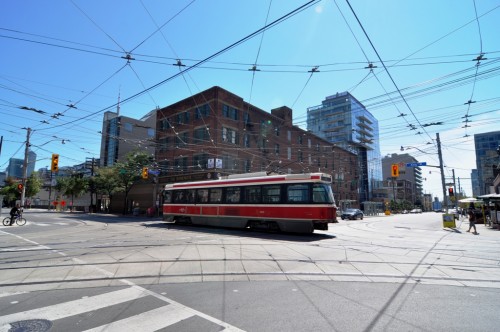
In a city often referred to as, “The New York City of Canada”, one might expect a wide range of culture, transportation and places to visit.  It was this notion that my family and I recently took with us as we traveled north of the border  for a pleasurable Labour Day weekend in Toronto, Ontario. I won’t lie, I was very excited to be visiting one of the North America’s premier metropolis’ and hoped to take advantage of the large number of alternative transportation options that Toronto plays host to.
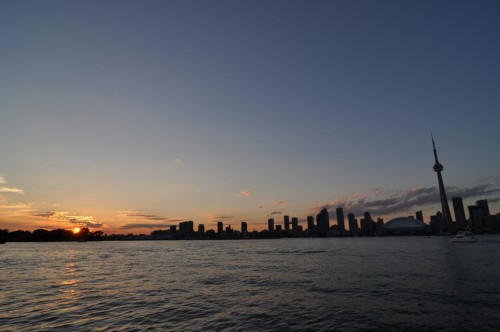
Toronto is home to one of North America’s most expansive urban rail networks. With numerous streetcar routes criss-crossing the city, TTC (Toronto Transit Commission) provided a launching pad for where my family chose a hotel. My wife is a full time artist and as luck would have it, the hotel we were lucky enough to uncover, The Gladstone, plays host to a number of rooms which have been rehabilitated by artists; each room exhibits a unique, self contained theme.

Located in the Queen Street West neighborhood the hotel is situated directly along the Queen Street streetcar route. With frequent service throughout the day and night, a dependable transportation option was quite literally, right out the front door. We parked our car on Friday evening and did not use it until we packed up to leave the following Monday morning. Actually riding the streetcars was quite a pleasurable experience due in part by the cultural diversity found on board. Sure the streetcar is a mode of transportation, but on board you could see why Toronto is another of North America’s melting pots; 49% of its population is foreign born and it shows when you look at the faces on the streetcar.
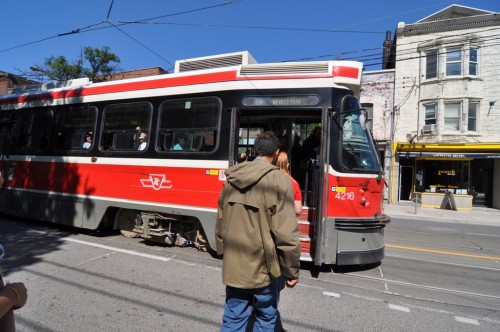
The boarding left a bit to be desired via steep, non ADA compliant style steps leading up to seating level. Additionally, purchasing day passes presented a challenge to us as there were no means to purchase passes at the sheltered stops. We had to find neighborhood vendors selling them. This was perhaps the only problematic quality of the service. The boarding process itself is unique. Since all the streetcar routes are situated in the median of the street they are located, and thus mixed with automobiles, buses and bikes, there are no actual “stops” as you would typically find here in America with the ongoing streetcar renaissance.

Shelters are located on the sidewalk at a number of intersections, or simply a sign on a pole indicating that the streetcar picks up and drops off there. The streetcar driver sees people waiting and stops at traffic lights forcing streetcar riders to cross a lane of traffic to reach the door. It is the law in Toronto for drivers to stop when a streetcar does to insure that those boarding do not get hit. It seemed foreign to me at first since I am accustomed to boarding urban rail cars at designated stops with shelters, maps, etc. Indeed, the Toronto experience is much less formal but the residents seem to simply accept it as the way it is and the system functions like a well oiled machine.
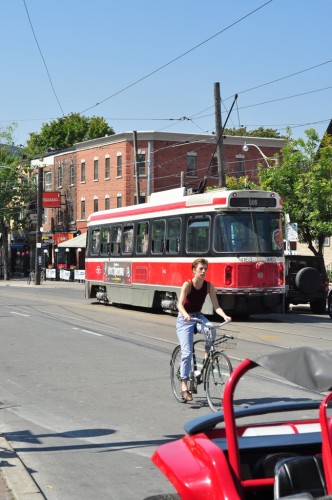
Toronto’s other urban rail service, the subway, is much less widespread within the inner city neighborhoods compared to the streetcar network and that being the case, we only took advantage of it once. The service however was superior to what I have found in other cities with the platforms exceedingly clean and the cars even more so. Toronto appears to be employing new cars in the subway as they looked brand new. The route maps inside of the cars were easy to read as well with the next stops literally represented by either a green or red dot to indicate which ones had been passed on the route. A commuter rail system named GO, similar to Chicago’s METRA, is also spread out in a hub and spoke pattern from the business district’s Union Station. We did not use this system either, but I witnessed a number of the green trains utilizing double-decker passenger cars.
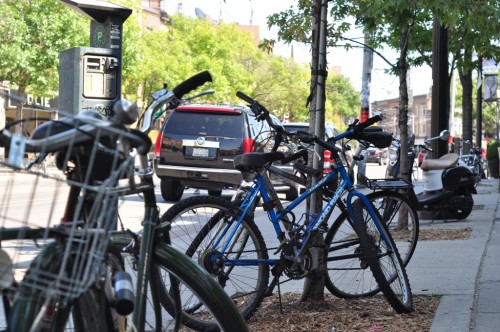
In America, one tool that urban rail advocates often advertise is rail’s ability to attract dense development around stations. Indeed, this was the case in some areas of Toronto even without a physical boarding area. The Queen Street West neighborhood where our hotel was located seemed to be immersed in an ongoing gentrification process. I delved into the history and found out that an artist spurred redevelopment of the area brought the redevelopment to the forefront approximately 5 years ago. The neighborhood is a true mixed income neighborhood with many storefronts and old apartment buildings in subpar condition located right next door to new multi-million dollar condo projects.
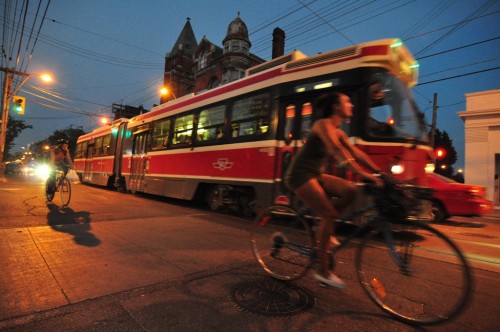
In addition to the widespread usage of the streetcar are the presence of cyclists EVERYWHERE. One gets the impression that cyclists, streetcars & motorists interact seamlessly with one another. Cyclists between streetcars and parked autos are a common site on any streetcar routes within the city. They are respectful of each other. One might advocate for bike lanes, but it appears that bike traffic flows without issue. There are cycling trails in the city, but within the old city neighborhoods, there does not appear to be much room available for expansion of them. A typical street cross section along streetcar routes is comprised of 4 lanes, with the 2 center lanes containing the rail and parking on each curb.
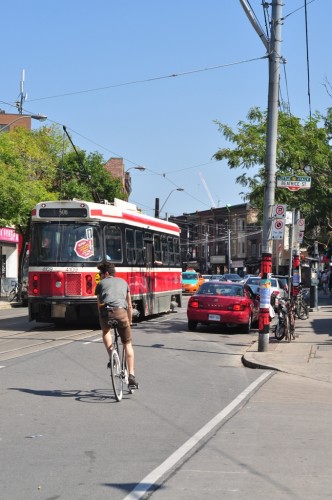
The experience left me inspired by the effectiveness of urban rail transit in the dense city environment of Toronto. Even on busy streets were autos mixed with electric streetcars, backups as a result of the streetcar appeared few and far between. The widespread acceptance of this form of rail in Toronto gives me hope that other North American urban centers can adopt rail transit and people will adjust and accept the transportation options available to people who desire more than a car to get around.
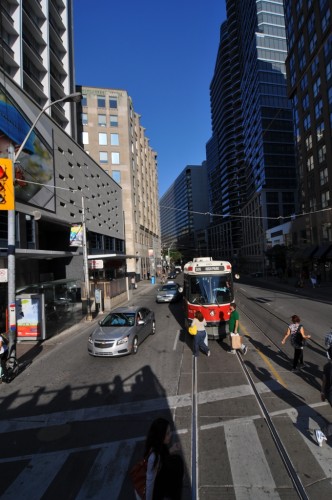
I love this article, thanks! I was able to visit Montreal and it seemed as if it were a city of culture as well.
My wife and I were in Montreal about 2 months ago and it was amazing how much transit and biking is just a part of the culture.
Well, I am happy to see some places get it when it comes to developing for the future.
I was in Toronto at the same time as Curt (no meet up, unfortunately) and got a chance to ride my bike about 20 miles around the downtown core. It was amazing to have drivers KNOW what to do when approaching a bike. You never felt like you were in the way and no one every acted like anyone else was in their way.
.
I mentioned to Curt in an email that Toronto has about equal quality and type of bike infrastructure as Indianapolis. Some full on trails (ala Monon), some separate bikeways (ala Shelby bike track), a decent amount of bike lanes and sharrows, but much of it, as mentioned, was not explicitly marked for bikes.
.
That being said, there were tons of bikes (I was in a group of about 10-15 commuters on Dundas at 7:30am) and, as I mentioned, the motorists reacted with a calm, “Ah – a bike.” In Indy, it always feels more like motorists are reacting with a “WTF is that guy doing on the road? Get off the car driving place!” I think the tipping point for drivers to become comfortable around bikes is still a ways off for Indy – maybe 10 years. But it is coming.
.
Also, I hope rail and street cars will be coming as well. Hopefully Curt can give us an update on the downtown/zoo street car loop that has been mentioned here before.
Thanks for sharing Curt. I have been to Toronto many years ago and was also impressed with the “New York City of Canada.”
Magnificent website you have. Good Information. Thanks for posting.
Only during the five months, from Dhanus ( Sagittarius ) to Mesha ( Aries), the plants need water, as during these months, rainfalls are almost nil.
As we all know, Car can not run without gasoline and human can not work without eating.
Many also prefer going for an adventurous activity. As they say “Women and shopping go hand in hand like men and tools” in
that they both look for the best deals and can never
have too many.
My blog eBay Discount Coupon